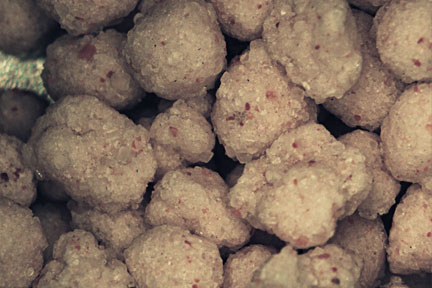FEECO’s lab is a truly inclusive facility, where technicians use a myriad of tools and processes to deliver ideal material testing solutions. An important, but often overlooked, tool used at FEECO is a state-of-the-art microscope and software program from Nikon. The microscope allows lab technicians and customers to see material features unbeknownst to the naked eye, features that help confirm the detailed characteristics of pellets, as well as raw samples and other agglomerates.
How it Works: Creating Full Depth View
The microscope takes approximately a dozen snapshots, all at different focal points, and then splices the image together to create one crisp image. The microscope is especially beneficial when working with pellets, because of their spherical shape. While other camera lenses focus on the top of the pellet, leaving the bottom blurry and vice versa, the microscope creates a clear image of the pellet as a whole.
Overall, the microscope uses zoom and detailed magnification functions to capture close-up, clear images of any material, at any stage of processing, in the lab. The microscope’s benefits are far and plenty for both FEECO’s lab technicians and customers.
Added Benefits throughout the Entire Lab Testing Process
FEECO works with countless materials in the lab, creating customized equipment and processing solutions. While no two lab trials are necessarily alike, one consistency remains: microscopes can be used in virtually all parts of the lab testing process, and they often are. Specifically, lab technicians use the microscope during:
Product and Process Development
Technicians closely compare pellets derived from various process configurations or changes in feedstock characteristics during the development stages.
Example: When developing the best pelletization process for a particular material, lab technicians use the microscope to view up-close images of each sample they create. With a magnified view, they see the material’s characteristics more easily, including overall color and possible color variations. Color variations often signify a binder discrepancy, meaning the liquid binder is not evenly distributed amongst the pellets.
Benefit: Magnified images either confirm or support the agglomeration goal, and allow lab technicians to re-configure any process that does not produce the customer’s desired end-product.
Comparative Studies
Lab technicians compare pellets that were agglomerated by FEECO, as well as samples brought in by customers.
Example: Customers often bring in pellets they processed prior to working with FEECO, as well as the material in its raw form. After learning the customer’s agglomeration goal, FEECO’s lab technicians pelletize the raw sample, and then use the microscope to take photos of both pelletized end-products. The comparisons frequently reveal a multitude of differences between the two pellet samples.
Benefit: The photos show magnified surface characteristics and composition, an important tool in confirming the best pelletized material sample.
Start and Finish Analysis
Close up images are taken of the material feed, or the material to be processed, and, most commonly, of the final product.
Example: After pelletizing a material, lab technicians assess the pellet’s surface characteristics under the microscope.
Benefit: Smooth pellet surface is a top customer request, and the microscope, compared to the naked eye, shows a much more accurate depiction of how smooth the exterior is.
The FEECO Advantage
The microscope shows the value of ultra-fine agglomeration processing, as the naked eye is incapable of seeing such minute details without magnification. With assistance from the microscope, FEECO’s lab technicians and customers are able to view close-up images, an important tool for assessing the material feed, end-product characteristics, and everything in between. The overall magnified images provide tangible confirmation of FEECO’s agglomeration processes. With a more easily seen end-product, customers can be sure the pellets have met their precise expectations. At FEECO, what you see is what you get.
FEECO welcomes any customer’s microscope photography requests during the lab testing process. For more information on the microscope’s benefits, capabilities, or software program, contact us today!



